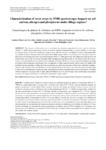Por favor, use este identificador para citar o enlazar este ítem:
http://www.alice.cnptia.embrapa.br/alice/handle/doc/1013554Registro completo de metadatos
| Campo DC | Valor | Lengua/Idioma |
|---|---|---|
| dc.contributor.author | CARVALHO, A. M. de | pt_BR |
| dc.contributor.author | MARCHAO, R. L. | pt_BR |
| dc.contributor.author | BUSTAMANTE, M. M. da C. | pt_BR |
| dc.contributor.author | ALCANTARA, F. A. de | pt_BR |
| dc.contributor.author | COSER, T. R. | pt_BR |
| dc.date.accessioned | 2015-04-15T11:11:11Z | pt_BR |
| dc.date.available | 2015-04-15T11:11:11Z | pt_BR |
| dc.date.created | 2015-04-15 | pt_BR |
| dc.date.issued | 2014 | pt_BR |
| dc.identifier.citation | Revista Ciência Agronômica, v. 45, n. 5, p. 968-975, 2014. | pt_BR |
| dc.identifier.issn | 1806-6690 | pt_BR |
| dc.identifier.uri | http://www.alice.cnptia.embrapa.br/alice/handle/doc/1013554 | pt_BR |
| dc.description | The objective of this study was to investigate the chemical composition of cover crops by solid-state CPMAS 13C NMR spectroscopy and its effects on carbon, nitrogen and phosphorus in a Typic Acrustox. Cover crops (Crotalaria juncea, Canavalia brasiliensis, Cajanus cajan, Mucuna pruriens and Raphanus sativus) and natural fallow were studied in rotation with maize under conventional and no-tillage regimes. Tissues of Crotalaria juncea, Canavalia brasiliensis, Mucuna pruriens and Raphanus sativus were analyzed using CPMAS 13C NMR spectroscopy. Soil samples were collected at the end of the growing season of the cover crops (September 2002) and during the grain filling period in corn from 0-5 and 5-10 cm layers. Cajanus cajan presented the lowest content of polysaccharides and along with Mucuna pruriens presented the highest percentage of aromatic carbon compounds, reflecting the slow decomposition of highly lignified material. Carbon stocks were higher in the superficial soil layer and under no-tillage due to the accumulation and slower decomposition of plant tissues under these conditions. Increases in the C/N ratio of the soil with Mucuna pruriens and the C/P ratio with Cajanus cajan in the dry season were also related to slower rates of decomposition, caused by the large concentration of aromatic compounds in the tissues of these species. The higher C/P ratios found at 0-5 cm layer are due to higher values of P (Mehlich-1) at 5-10 cm (25 mg kg-1) layer and the higher concentration of carbon in the superficial soil layer as a result of the accumulation of plant residues. | pt_BR |
| dc.language.iso | eng | eng |
| dc.rights | openAccess | eng |
| dc.subject | Ressonância magnetica nuclear | pt_BR |
| dc.subject | Latossolo Vermelho-Amarelo | pt_BR |
| dc.title | Characterization of cover crops by NMR spectroscopy: impacts on soil carbon, nitrogen and phosphorus under tillage regimes. | pt_BR |
| dc.type | Artigo de periódico | pt_BR |
| dc.date.updated | 2015-04-15T11:11:11Z | pt_BR |
| dc.subject.thesagro | Cerrado | pt_BR |
| dc.subject.thesagro | Carbono | pt_BR |
| dc.subject.thesagro | Matéria Orgânica | pt_BR |
| dc.subject.thesagro | Planta de Cobertura | pt_BR |
| riaa.ainfo.id | 1013554 | pt_BR |
| riaa.ainfo.lastupdate | 2015-04-15 | pt_BR |
| dc.contributor.institution | ARMINDA MOREIRA DE CARVALHO, CPAC; ROBELIO LEANDRO MARCHAO, CPAC; MERCEDES MARIA DA CUNHA BUSTAMANTE; FLAVIA APARECIDA DE ALCANTARA, CNPAF; THAIS RODRIGUES COSER. | pt_BR |
| Aparece en las colecciones: | Artigo em periódico indexado (CNPAF)  | |
Ficheros en este ítem:
| Fichero | Descripción | Tamaño | Formato | |
|---|---|---|---|---|
| rca.pdf | 128,65 kB | Adobe PDF |  Visualizar/Abrir |









